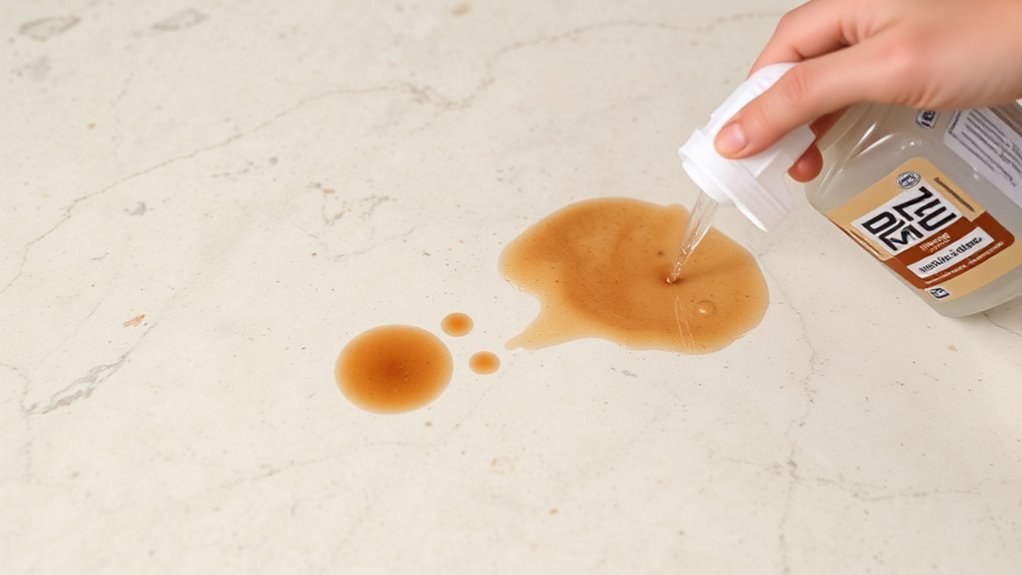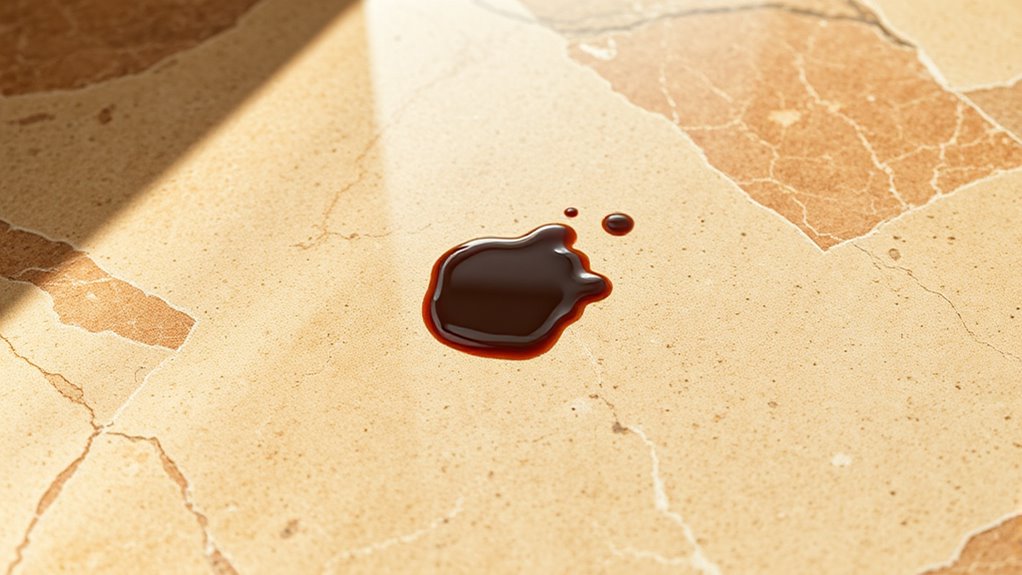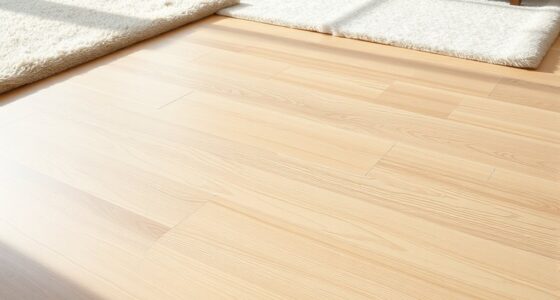To remove coffee, wine, and grease stains from natural stone quickly, act immediately by blotting the spill with a soft cloth, avoiding rubbing. For grease, sprinkle baking soda or cornstarch and let it sit overnight to absorb oils. Use a pH-neutral stone cleaner for stubborn stains and consider a poultice for deep discolorations. Keep your surface sealed and clean regularly to prevent future stains—learn more about effective stain removal techniques to keep your stone looking pristine.
Key Takeaways
- Blot fresh coffee or wine spills immediately with a soft cloth, avoiding rubbing to prevent deeper penetration.
- For grease stains, apply absorbent powders like baking soda or cornstarch directly on the spill and leave overnight.
- Use a pH-neutral stone cleaner and a soft cloth to gently scrub stained areas, then rinse thoroughly.
- For stubborn stains, create a poultice with a gentle cleaning agent, cover, and leave for 24-48 hours before rinsing.
- Seal stone regularly and use coasters, trivets, and immediate cleaning to prevent future stains and ease removal.

Natural stone surfaces add elegance to any space, but stains can quickly mar their beauty. When spills happen—like coffee, wine, or grease—you need to act fast to prevent permanent damage. Knowing effective cleaning techniques and implementing preventative measures can save your stone from lasting stains and maintain its stunning appearance.
First, address stains as soon as possible. For fresh coffee or wine spills, blot the area immediately with a soft cloth or paper towel. Avoid rubbing, as this can push the stain deeper into the porous surface. After blotting, rinse the spot with clean water to remove any residual liquid and gently dry with a towel. Quick action minimizes absorption and makes cleaning easier. For grease stains, the key is to absorb the oil quickly. Place an absorbent material like baking soda or cornstarch over the spill and let it sit for several hours—preferably overnight. This helps draw out the grease before it penetrates the stone.
Prompted to act quickly: blot fresh spills with soft cloth and let absorbent powders sit overnight to prevent stains.
When it comes to cleaning techniques, use pH-neutral cleaners specifically formulated for natural stone. Harsh chemicals or acidic solutions can etch or dull the surface, worsening the stain or creating new damage. Mix a mild stone cleaner with water, and apply it with a soft cloth or sponge, gently scrubbing the stained area. Rinse thoroughly with clean water afterward to remove any residue. For stubborn stains, you might need a poultice—an absorbent paste that pulls stain material from the stone. Apply the poultice over the stain, cover with plastic wrap, and leave it to work for 24-48 hours. Then, remove the poultice and rinse the area thoroughly.
Preventative measures are your best defense against stains. Seal your natural stone regularly with a high-quality sealer to create a protective barrier. This makes it harder for liquids to penetrate, giving you more time to clean up spills before they set. Place coasters under glasses, especially those containing wine or coffee, and use trivets or mats under greasy cookware. Wipe down surfaces immediately after use, and avoid leaving spills to sit for extended periods. Regularly cleaning your stone with gentle, pH-neutral products also prevents the buildup of grime that can trap stains.
Frequently Asked Questions
Can Natural Stone Stains Be Permanently Removed?
Natural stone stains can sometimes be permanently removed if you act quickly with proper stain removal techniques. You should identify the stain type and use appropriate cleaning methods, like poultices, to lift stubborn spots. Regular natural stone maintenance helps prevent deep-set stains. Keep in mind, some stains may be difficult to fully eliminate, so consistent care and professional restoration may be necessary for the best results.
Are Commercial Stain Removers Safe for All Stone Types?
Commercial stain removers aren’t safe for all stone types because they often contain chemical cleaners that can damage delicate surfaces. You should always check the manufacturer’s instructions before use. Instead, consider DIY solutions like a baking soda paste or a gentle pH-balanced cleaner. These safer options help you effectively remove stains without risking harm to your natural stone, ensuring its beauty stays intact.
How Often Should I Reseal My Natural Stone Surfaces?
Sealing schedules should suit your stone’s surface and usage. Typically, resealing tips suggest every 1 to 3 years, depending on traffic and wear. To keep your stone pristine, monitor for dullness or stains, and reseal when needed. Regularly check the sealing frequency, maintain meticulous maintenance, and follow simple resealing tips to prolong your natural stone’s life, beauty, and brilliance.
What Are Natural Remedies for Stubborn Stains?
For stubborn stains, try homemade solutions and herbal remedies. Mix baking soda with water to form a paste, then apply it to the stain, letting it sit for a few hours before gently scrubbing. You can also use diluted hydrogen peroxide or lemon juice for milder stains. Remember to test any remedy on a small area first to avoid damage. These natural options often work effectively without harsh chemicals.
Does Cleaning With Vinegar Damage Natural Stone?
Cleaning with vinegar can harm natural stone because vinegar’s acidity can damage the stone’s surface and compromise its natural stone integrity. Vinegar safety isn’t guaranteed for natural stone, so it’s best to avoid using it directly. Instead, opt for pH-neutral cleaners designed specifically for natural stone, which effectively remove stains without risking damage. Protect your surfaces and preserve their beauty by choosing gentle, stone-safe cleaning methods.
Conclusion
Now that you know how to tackle stains on your natural stone quickly, there’s no need to panic when spills happen. Just follow these simple steps, and your surface will look pristine in no time—almost like magic! Remember, a little effort goes a long way in keeping your stone beautiful and stain-free. With these tips, you’ll be the superhero of your home, saving your surfaces from disaster faster than you can say “clean!”









